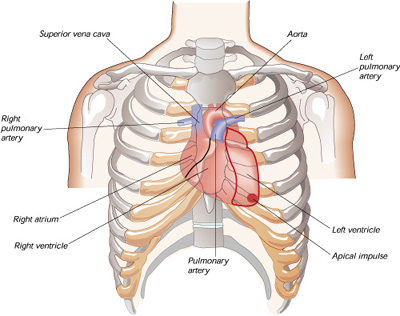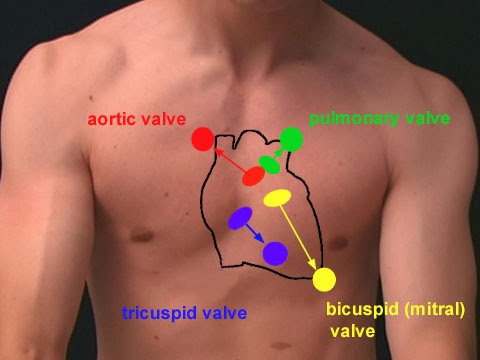It is important to know what side is your heart on to be able to understand if the pain you're experiencing has something to do with your heart. If it's on the side of your heart, it could be because you're having a heart attack. Knowledge about the location of your heart will prove beneficial in many cases. Keep reading to find out more about why it matters to learn which side is your heart on.
What Side Is Your Heart On?
Do you think your heart is on the left side of your chest? Most people think the same, but the truth is that your heart is located between your right and left lung. It means your heart is in middle of your chest, with a slight tilt towards the left. Located in the front and middle of your chest, your heart is no bigger than the size of your clenched fist. A wall separates the left and right of your heart, and each of these sides has a small chamber called atrium. The chamber then leads into a large pumping chamber known as ventricle. Your heart has four chambers, called right ventricle and right atrium, and then left atrium and left ventricle.


Warning Signs of Pain Originating in the Heart
It is common to experience chest pain after exertion or due to many different reasons. However, you must have knowledge about what side is your heart on as well as the warning signs of heart pain.
Heart Attack
Also called myocardial infarction, this happens due to reduced blood flow through heart blood vessels. This leads to the death of heart muscle cells and cause permanent damage. The pain you experience in a heart attack is quite similar to angina, but it will be more severe in case of myocardial infarction.
Unlike what you see on TV, not all heart attacks will begin with crushing chest pain that hits you out of nowhere. About one-third of the patients who had heart attacks never experienced any chest pain. It means the symptoms of heart attack will vary from person to person. Some people may experience a few symptoms, while others may feel excruciating pain when they have a heart attack. Research shows heart attacks can start slowly with mild, bearable pain, whereas people with high blood sugar may not experience any symptoms at all. Women may experience symptoms like nausea, shortness of breath, unusual tiredness, vomiting, and pain in the back, jaw, and shoulder. The most common symptoms include the following:
- Chest Pain: Most patients will experience some degree of chest pain and discomfort in the left side of the chest. The discomfort may come and go after a few minutes. It may feel like pressure, fullness, squeezing, or pain.
- Upper Body Discomfort: You may experience pain or discomfort in your upper body, including your arms, shoulders, back, jaw, neck, or upper part of your stomach.
- Shortness of Breath: You may experience shortness of breath with or without chest pain. It will aggravate with a little bit of physical activity.
- Some other common symptoms include feeling tired, breaking out in a cold sweat, light-headedness, nausea, and vomiting. It is important to bear in mind that sometimes you only experience symptoms of angina, which occurs in people with coronary heart disease. Angina pain usually goes away with rest.
A heart attack is the common cause of chest pain, but you may experience pain in your chest due to many other conditions as well. You should know about what side is your heart on to be able to understand that you're having a heart problem that needs immediate attention.
Coronary Artery Disease (CAD)
It refers to a condition caused by a blockage in the heart blood vessels. This blockage reduces oxygen and blood flow to the heart muscle and causes pain known as angina. Though it's a heart disease, it doesn't cause any permanent damage to your heart. However, it makes you more susceptible to a heart attack. If you have a coronary artery disease, you will also experience pain in your jaw, shoulder, arm, or back. The pain will feel more like a squeezing sensation. Excitement, exercise, and emotional stress can aggravate your pain.
Myocarditis
This refers to heart muscle inflammation that may also cause fatigue, fever, trouble breathing, and fast heartbeat. The pain in myocarditis may feel like a heart attack, there is usually no blockage involved in arteries or vessels.
Pericarditis
The sac around the heart may become inflamed and cause severe pain that is quite similar to angina. You may also feel a sharp, consistent pain along the shoulder muscle and upper neck. It may become worse with swallowing, breathing, and lying on your back.
Hypertrophic Cardiomyopathy
This genetic disease makes your heart muscle grow abnormally thick. This may cause several problems related to blood flow out of your heart, which will result in shortness of breath and chest pain, especially after exercise. You will also experience issues like fainting, lightheadedness, dizziness, and other symptoms. You will eventually have a heart failure when your heart muscle becomes very thick.
Mitral Valve Prolapse
In this condition, a valve of your heart doesn’t close properly, which causes several symptoms such as palpitations, chest pain, and dizziness.
Coronary Artery Dissection
This rare but serious condition is caused by a tear that develops in the coronary artery. You may experience excruciating pain that hits you suddenly and goes up into the back, neck, or abdomen.
What About Pain on the Right Side of Chest?
Once you know you which side your heart is on, you will be in a better position to determine if it's serious or not. Still, it is a good idea to go see your doctor to evaluate your chest pain and find the underlying cause of problem. However, if you experience pain on the right side of your chest, this is usually not associated with heart pain. It is not heart pain especially when it gets worse with taking a deep breath. The only way to associate your pain on the right side with your heart is to link the pain with the outer sac surrounding the heart. This happens only in rare cases, but your pain could be due to the inflammation of the outer lining of your lungs. This may happen due to pneumonia if you're also experiencing fever and shortness of breath. A trauma to your chest may also lead to severe chest pain.
Never overlook any chest pain and have it evaluated by your healthcare provider to rule out the possibility of having a serious heart disease or another issue. Click here to know about differences between cardiac and non-cardiac chest pain.
